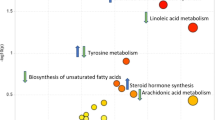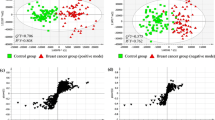Abstract
Evaluation of protein and metabolite expression patterns in blood using mass spectrometry and high-throughput antibody-based screening platforms has potential for the discovery of new biomarkers for managing breast cancer patient treatment. Previously identified blood-based breast cancer biomarkers, including cancer antigen 15.3 (CA15-3) are useful in combination with imaging (computed tomography scans, magnetic resonance imaging, X-rays) and physical examination for monitoring tumour burden in advanced breast cancer patients. However, these biomarkers suffer from insufficient levels of accuracy and with new therapies available for the treatment of breast cancer, there is an urgent need for reliable, non-invasive biomarkers that measure tumour burden with high sensitivity and specificity so as to provide early warning of the need to switch to an alternative treatment. The aim of this study was to identify a biomarker signature of tumour burden using cancer and non-cancer (healthy controls/non-malignant breast disease) patient samples. Results demonstrate that combinations of three candidate biomarkers from Glutamate, 12-Hydroxyeicosatetraenoic acid, Beta-hydroxybutyrate, Factor V and Matrix metalloproteinase-1 with CA15-3, an established biomarker for breast cancer, were found to mirror tumour burden, with AUC values ranging from 0.71 to 0.98 when comparing non-malignant breast disease to the different stages of breast cancer. Further validation of these biomarker panels could potentially facilitate the management of breast cancer patients, especially to assess changes in tumour burden in combination with imaging and physical examination.

Similar content being viewed by others
References
Asiago, V. M., Alvarado, L. Z., Shanaiah, N., Gowda, G. A., Owusu-Sarfo, K., Ballas, R. A., et al. (2010). Early detection of recurrent breast cancer using metabolite profiling. Cancer Research, 70(21), 8309–8318. doi:10.1158/0008-5472.CAN-10-1319.
Benson, J. R., & Jatoi, I. (2012). The global breast cancer burden. Future Oncology, 8(6), 697–702. doi:10.2217/fon.12.61.
Bhattacharya, P., & Maity, P. (2000). Localization of phosphate dependent glutaminase in ascites fluid of ovarian cancer patient. Pathology and Oncology Research, 6(3), 217–223.
Bigbee, W. L., Gopalakrishnan, V., Weissfeld, J. L., Wilson, D. O., Dacic, S., Lokshin, A. E., et al. (2012). A multiplexed serum biomarker immunoassay panel discriminates clinical lung cancer patients from high-risk individuals found to be cancer-free by CT screening. Journal of Thoracic Oncology, 7(4), 698–708. doi:10.1097/JTO.0b013e31824ab6b0.
Boström, P., Söderström, M., Vahlberg, T., Söderström, K. O., Roberts, P. J., Carpén, O., et al. (2011). MMP-1 expression has an independent prognostic value in breast cancer. BMC Cancer, 11, 348. doi:10.1186/1471-2407-11-348.
Brayman, M., Thathiah, A., & Carson, D. D. (2004). MUC1: A multifunctional cell surface component of reproductive tissue epithelia. Reproductive Biology and Endocrinology, 2, 4. doi:10.1186/1477-7827-2-4.
Dowling, P., Clarke, C., Hennessy, K., Torralbo-Lopez, B., Ballot, J., Crown, J., et al. (2012). Analysis of acute-phase proteins, AHSG, C3, CLI, HP and SAA, reveals distinctive expression patterns associated with breast, colorectal and lung cancer. International Journal of Cancer, 131(4), 911–923. doi:10.1002/ijc.26462.
Drukteinis, J. S., Mooney, B. P., Flowers, C. I., & Gatenby, R. A. (2013). Beyond mammography: New frontiers in breast cancer screening. American Journal of Medicine, 126(6), 472–479. doi:10.1016/j.amjmed.2012.11.025.
Duffy, M. J. (2006). Serum tumor markers in breast cancer: Are they of clinical value? Clinical Chemistry, 52(3), 345–351. doi:10.1373/clinchem.2005.059832.
Duffy, M. J. (2013). Tumor markers in clinical practice: A review focusing on common solid cancers. Medical Principles and Practice, 22(1), 4–11. doi:10.1159/000338393.
Duffy, M. J., Evoy, D., & McDermott, E. W. (2010). CA 15-3: Uses and limitation as a biomarker for breast cancer. Clinica Chimica Acta, 411(23–24), 1869–1874. doi:10.1016/j.cca.2010.08.039.
Erickson, J. W., & Cerione, R. A. (2010). Glutaminase: A hot spot for regulation of cancer cell metabolism? Oncotarget, 1(8), 734–740.
Fürstenberger, G., Krieg, P., Müller-Decker, K., & Habenicht, A. J. (2006). What are cyclooxygenases and lipoxygenases doing in the driver’s seat of carcinogenesis? International Journal of Cancer, 119(10), 2247–2254. doi:10.1002/ijc.22153.
Graham, L. J., Shupe, M. P., Schneble, E. J., Flynt, F. L., Clemenshaw, M. N., Kirkpatrick, A. D., et al. (2014). Current approaches and challenges in monitoring treatment responses in breast cancer. Journal of Cancer, 5(1), 58–68. doi:10.7150/jca.7047.
Haagensen, D. E., Kister, S. J., Vandevoorde, J. P., Gates, J. B., Smart, E. K., Hansen, H. J., et al. (1978). Evaluation of carcinoembryonic antigen as a plasma monitor for human breast carcinoma. Cancer, 42(3 Suppl), 1512–1519.
Harris, L., Fritsche, H., Mennel, R., Norton, L., Ravdin, P., Taube, S., et al. (2007). American Society of Clinical Oncology 2007 update of recommendations for the use of tumor markers in breast cancer. Journal of Clinical Oncology, 25(33), 5287–5312. doi:10.1200/JCO.2007.14.2364.
Hayes, D. F., Sekine, H., Ohno, T., Abe, M., Keefe, K., & Kufe, D. W. (1985). Use of a murine monoclonal antibody for detection of circulating plasma DF3 antigen levels in breast cancer patients. Journal of Clinical Investigation, 75(5), 1671–1678. doi:10.1172/JCI111875.
Jiang, W. G., Douglas-Jones, A., & Mansel, R. E. (2003). Levels of expression of lipoxygenases and cyclooxygenase-2 in human breast cancer. Prostaglandins Leukotrienes and Essential Fatty Acids, 69(4), 275–281.
Katt, W. P., Ramachandran, S., Erickson, J. W., & Cerione, R. A. (2012). Dibenzophenanthridines as inhibitors of glutaminase C and cancer cell proliferation. Molecular Cancer Therapeutics, 11(6), 1269–1278. doi:10.1158/1535-7163.MCT-11-0942.
Klee, E. W., Bondar, O. P., Goodmanson, M. K., Dyer, R. B., Erdogan, S., Bergstralh, E. J., et al. (2012). Candidate serum biomarkers for prostate adenocarcinoma identified by mRNA differences in prostate tissue and verified with protein measurements in tissue and blood. Clinical Chemistry, 58(3), 599–609. doi:10.1373/clinchem.2011.171637.
Koochekpour, S., Majumdar, S., Azabdaftari, G., Attwood, K., Scioneaux, R., Subramani, D., et al. (2012). Serum glutamate levels correlate with Gleason score and glutamate blockade decreases proliferation, migration, and invasion and induces apoptosis in prostate cancer cells. Clinical Cancer Research, 18(21), 5888–5901. doi:10.1158/1078-0432.CCR-12-1308.
Koppenol, W. H., Bounds, P. L., & Dang, C. V. (2011). Otto Warburg’s contributions to current concepts of cancer metabolism. Nature Reviews Cancer, 11(5), 325–337. doi:10.1038/nrc3038.
Kurebayashi, J., Nishimura, R., Tanaka, K., Kohno, N., Kurosumi, M., Moriya, T., et al. (2004). Significance of serum tumor markers in monitoring advanced breast cancer patients treated with systemic therapy: A prospective study. Breast Cancer, 11(4), 389–395.
Ławicki, S., Będkowska, G. E., & Szmitkowski, M. (2013). VEGF, M-CSF and CA 15-3 as a new tumor marker panel in breast malignancies: A multivariate analysis with ROC curve. Growth Factors, 31(3), 98–105. doi:10.3109/08977194.2013.797900.
Liu, B., Maher, R. J., Hannun, Y. A., Porter, A. T., & Honn, K. V. (1994). 12(S)-HETE enhancement of prostate tumor cell invasion: Selective role of PKC alpha. Journal of the National Cancer Institute, 86(15), 1145–1151.
Lokich, J. J., Zamcheck, N., & Lowenstein, M. W. (1978). Sequential carcinoembryonic antigen levels in the therapy of metastatic breast cancer: A predictor and monitor of response and relapse. Annals of Internal Medicine, 89(6), 902–906.
Meleady, P., Gallagher, M., Clarke, C., Henry, M., Sanchez, N., Barron, N., et al. (2012a). Impact of miR-7 over-expression on the proteome of Chinese hamster ovary cells. Journal of Biotechnology, 160(3–4), 251–262. doi:10.1016/j.jbiotec.2012.03.002.
Meleady, P., Hoffrogge, R., Henry, M., Rupp, O., Bort, J. H., Clarke, C., et al. (2012b). Utilization and evaluation of CHO-specific sequence databases for mass spectrometry based proteomics. Biotechnology and Bioengineering, 109(6), 1386–1394. doi:10.1002/bit.24476.
Milan, E., Lazzari, C., Anand, S., Floriani, I., Torri, V., Sorlini, C., et al. (2012). SAA1 is over-expressed in plasma of non small cell lung cancer patients with poor outcome after treatment with epidermal growth factor receptor tyrosine-kinase inhibitors. Journal of Proteomics, 76 91–101, doi:10.1016/j.jprot.2012.06.022.
Mirabelli, P., & Incoronato, M. (2013). Usefulness of traditional serum biomarkers for management of breast cancer patients. BioMed Research International, 2013, 685641. doi:10.1155/2013/685641.
Molina, R., Augé, J. M., Escudero, J. M., Filella, X., Zanon, G., Pahisa, J., et al. (2010a). Evaluation of tumor markers (HER-2/neu oncoprotein, CEA, and CA 15.3) in patients with locoregional breast cancer: Prognostic value. Tumour Biology, 31(3), 171–180. doi:10.1007/s13277-010-0025-9.
Molina, R., Auge, J. M., Farrus, B., Zanón, G., Pahisa, J., Muñoz, M., et al. (2010b). Prospective evaluation of carcinoembryonic antigen (CEA) and carbohydrate antigen 15.3 (CA 15.3) in patients with primary locoregional breast cancer. Clinical Chemistry, 56(7), 1148–1157. doi:10.1373/clinchem.2009.135566.
Molina, R., Barak, V., van Dalen, A., Duffy, M. J., Einarsson, R., Gion, M., et al. (2005). Tumor markers in breast cancer-European Group on Tumor Markers recommendations. Tumour Biology, 26(6), 281–293. doi:10.1159/000089260.
Monari, E., Casali, C., Cuoghi, A., Nesci, J., Bellei, E., Bergamini, S., et al. (2011). Enriched sera protein profiling for detection of non-small cell lung cancer biomarkers. Proteome Science, 9(1), 55. doi:10.1186/1477-5956-9-55.
Moreno-Aspitia, A., Hillman, D. W., Dyar, S. H., Tenner, K. S., Gralow, J., Kaufman, P. A., et al. (2013). Soluble human epidermal growth factor receptor 2 (HER2) levels in patients with HER2-positive breast cancer receiving chemotherapy with or without trastuzumab: Results from North Central Cancer Treatment Group adjuvant trial N9831. Cancer, 119(15), 2675–2682. doi:10.1002/cncr.28130.
Mughal, A. W., Hortobagyi, G. N., Fritsche, H. A., Buzdar, A. U., Yap, H. Y., & Blumenschein, G. R. (1983). Serial plasma carcinoembryonic antigen measurements during treatment of metastatic breast cancer. JAMA, 249(14), 1881–1886.
Nakata, B., Ogawa, Y., Ishikawa, T., Ikeda, K., Kato, Y., Nishino, H., et al. (2000). Serum CYFRA 21-1 is one of the most reliable tumor markers for breast carcinoma. Cancer, 89(6), 1285–1290.
Namkoong, J., Shin, S. S., Lee, H. J., Marín, Y. E., Wall, B. A., Goydos, J. S., et al. (2007). Metabotropic glutamate receptor 1 and glutamate signaling in human melanoma. Cancer Research, 67(5), 2298–2305. doi:10.1158/0008-5472.CAN-06-3665.
Park, B. J., Cha, M. K., & Kim, I. H. (2014). Thioredoxin 1 as a serum marker for breast cancer and its use in combination with CEA or CA15-3 for improving the sensitivity of breast cancer diagnoses. BMC Research Notes, 7(1), 7. doi:10.1186/1756-0500-7-7.
Ripka, S., Riedel, J., Neesse, A., Griesmann, H., Buchholz, M., Ellenrieder, V., et al. (2010). Glutamate receptor GRIA3-target of CUX1 and mediator of tumor progression in pancreatic cancer. Neoplasia, 12(8), 659–667.
Senkus, E., Cardoso, F., & Pagani, O. (2014). Time for more optimism in metastatic breast cancer? Cancer Treatment Reviews, 40(2), 220–228. doi:10.1016/j.ctrv.2013.09.015.
Seregni, E., Coli, A., Mazzucca, N., & Italian Group RIA-IRMA Test, I. a. A. o. N. M. (2004). Circulating tumour markers in breast cancer. European Journal of Nuclear Medicine and Molecular Imaging, 31(Suppl 1), S15–S22. doi:10.1007/s00259-004-1523-z.
Singh, A. K., Kant, S., Parshad, R., Banerjee, N., & Dey, S. (2011). Evaluation of human LOX-12 as a serum marker for breast cancer. Biochemical and Biophysical Research Communications, 414(2), 304–308. doi:10.1016/j.bbrc.2011.09.044.
Soerjomataram, I., Lortet-Tieulent, J., Parkin, D. M., Ferlay, J., Mathers, C., Forman, D., et al. (2012). Global burden of cancer in 2008: A systematic analysis of disability-adjusted life-years in 12 world regions. Lancet, 380(9856), 1840–1850. doi:10.1016/S0140-6736(12)60919-2.
Speyer, C. L., Smith, J. S., Banda, M., DeVries, J. A., Mekani, T., & Gorski, D. H. (2012). Metabotropic glutamate receptor-1: A potential therapeutic target for the treatment of breast cancer. Breast Cancer Research and Treatment, 132(2), 565–573. doi:10.1007/s10549-011-1624-x.
Tondini, C., Hayes, D. F., Gelman, R., Henderson, I. C., & Kufe, D. W. (1988). Comparison of CA15-3 and carcinoembryonic antigen in monitoring the clinical course of patients with metastatic breast cancer. Cancer Research, 48(14), 4107–4112.
Vonach, C., Viola, K., Giessrigl, B., Huttary, N., Raab, I., Kalt, R., et al. (2011). NF-κB mediates the 12(S)-HETE-induced endothelial to mesenchymal transition of lymphendothelial cells during the intravasation of breast carcinoma cells. British Journal of Cancer, 105(2), 263–271. doi:10.1038/bjc.2011.194.
Zhao, Y., Butler, E. B., & Tan, M. (2013). Targeting cellular metabolism to improve cancer therapeutics. Cell Death and Disease, 4, e532. doi:10.1038/cddis.2013.60.
Acknowledgments
The All-Ireland Cooperative Oncology Research Group (ICORG) assisted in the provision of clinical samples. This work was supported by funding from Enterprise Ireland (EI) [Grant number CF20122012].
Author information
Authors and Affiliations
Corresponding author
Additional information
Paul Dowling and Michael Henry are joint authors.
Michael Moriarty and Martin Clynes are joint authors.
Electronic supplementary material
Below is the link to the electronic supplementary material.
Rights and permissions
About this article
Cite this article
Dowling, P., Henry, M., Meleady, P. et al. Metabolomic and proteomic analysis of breast cancer patient samples suggests that glutamate and 12-HETE in combination with CA15-3 may be useful biomarkers reflecting tumour burden. Metabolomics 11, 620–635 (2015). https://doi.org/10.1007/s11306-014-0723-1
Received:
Accepted:
Published:
Issue Date:
DOI: https://doi.org/10.1007/s11306-014-0723-1




